NCERT Solutions for Class 8 Science Chapter 16 Light
NCERT Solutions for Class 8 Science Chapter 16 Light are given below. Here we have provided the best and error-free answers to all the exercise questions that will strengthen your foundation in science. Solving NCERT questions will assist you in grasping the content in the Crop Production and Management chapter in a better way.
In these solutions, we have answered all the intext and exercise questions provided in NCERT class 8 science textbook. NCERT Solutions for Class 8 Science Chapter 16 Light provided in this article are strictly based on the CBSE syllabus and curriculum. Students can easily download these solutions in PDF format for free or can read them online.
Light Class 8 Science NCERT Solutions
Exercise Questions
Question 1: Suppose you are in a dark room. Can you see objects in the room? Can you see objects outside the room? Explain.
Answer: We can see any object when light reflected by that object reaches to our eyes. But in the dark room, no light is reflected by the object. Hence, we are not able to see the objects in dark room. But if there is light outside the room, we can see the objects lying out there.
Question 2: Differentiate between regular and diffused reflection. Does diffused reflection mean the failure of the laws of reflection?
Answer:
| Regular Reflection | Diffused Reflection |
| It takes place from a smooth place. | It takes place from a rough surface. |
| Reflected rays moves in a particular direction. | Reflected rays scattered in random directions. |
| Example: Reflection by plane mirror. | Reflection by road surface. |
Question 3: Mention against each of the following whether regular or diffused reflection will take place when a beam of light strikes. Justify your answer in each case.
(a) Polished wooden table
(b) Chalk powder
(c) Cardboard surface over it
(d) Marble floor with water spread
(e) Mirror
(f) Piece of paper
Answer:
(a) Polished wooden table → Regular reflection
A polished surface is an example of a smooth surface. A polished wooden table has a smooth surface. Hence, reflections from the polished table will be regular.
(b) Chalk powder → Diffused reflection
Chalk powder has an irregular surface. So, when a beam of light reflects from it, a diffused reflection will take place.
(c) Cardboard surface → Diffused reflection
Cardboard has an irregular surface. So, when a beam of light reflects from it, a diffused reflection will take place.
(d) Marble floor with water spread over it → Regular reflection
Marble floor with water spread over it is an example of a regular surface. This is because water makes the marble surface smooth. Hence, regular reflection will take place from this surface.
(e) Mirror → Regular reflection
A mirror has a smooth surface. So, when a beam of light reflects from it, a regular reflection will take place.
(f) Piece of paper → Diffused reflection
A piece of paper may appear smooth but it has many minor irregularities. So, when a beam of light reflects from it, a diffused reflection will take place.
Question 4: State the laws of reflection.
Answer: Laws of reflection states that:
(i) The angle of incidence is always equal to the angle of reflection.
(ii) The incident ray, the reflected ray and the normal to the surface at the point of incidence lie in the same plane.
Question 5: Describe an activity to show that the incident ray, the reflected ray and the normal at the point of incidence lie in the same plane.
Answer: Fix a white sheet of stiff paper on a drawing board or a table. Let the sheet project a little beyond the edge of the table. Take a comb and close all its openings except one in the middle with the help of a black paper. Hold the comb perpendicular to the sheet of paper. Throw light from a torch through the opening of the comb from one side so that a ray of light can be seen along the paper on the other side of the comb. Place a strip of plane mirror in the path of the light ray. This ray of light striking the mirror is called the incident ray. After striking the mirror, the ray of light is reflected in another direction. This is called the reflected ray.
Now, cut the projecting portion of the sheet in the middle. Look at the reflected ray. Make sure that the reflected ray extends to the projected portion of the paper. Bend that part of the projected portion on which the reflected ray falls. The reflected ray that fell along this part can no longer be seen.This shows that the incident ray, the reflected ray and the normal at the point of incidence lie in the same plane.
Question 6. Fill in the blanks in the following.
(a) A person 1 m in front of a plane mirror seems to be _______________ m away from his image.
(b) If you touch your ____________ ear with right hand in front of a plane mirror it will be seen in the mirror that your right ear is touched with ____________.
(c) The size of the pupil becomes ____________ when you see in dim light.
(d) Night birds have ____________ cones than rods in their eyes.
Answer:
(a) A person 1 m in front of a plane mirror seems to be 2m away from his image.
(b) If you touch your left ear with right hand in front of a plane mirror it will be seen in the mirror that your right ear is touched with the left hand.
(c) The size of the pupil becomes large when you see in dim light.
(d) Night birds have fewer cones than rods in their eyes.
Question 7: Angle of incidence is equal to the angle of reflection.
(a) Always
(b) Sometimes
(c) Under special conditions
(d) Never
Answer: (a) Always
The angle of incidence is always equal to the angle of reflection. This is the first law of reflection.
Question 8: Image formed by a plane mirror is
(a) virtual, behind the mirror and enlarged.
(b) virtual, behind the mirror and of the same size as the object.
(c) real at the surface of the mirror and enlarged.
(d) real, behind the mirror and of the same size as the object.
Answer: (b) virtual, behind the mirror and of the same size as the object.
The image formed by a plane mirror is of the same size as the object. The image is formed behind the mirror. The image cannot be obtained on a screen. Hence, it is a virtual image.
Question 9: Describe the construction of a kaleidoscope.
Answer: A kaleidoscope is made up of three rectangular mirror strips joined together to form a prism. These are fixed in circular cardboard-like tube or tube of a thick chart paper. The tube is slightly longer than the mirror strips. One end of the tube remains closed by a cardboard disc having a hole in the centre, through which one can see. To make the disc durable, a piece of transparent plastic sheet is pasted under the cardboard disc. At the other end, touching the mirrors, a circular plane glass plate is fixed. On this glass plate, several small pieces of coloured glass are placed to form multiple images.
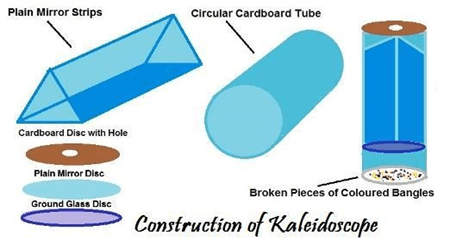
Question 10: Draw a labelled sketch of the human eye.
Answer:
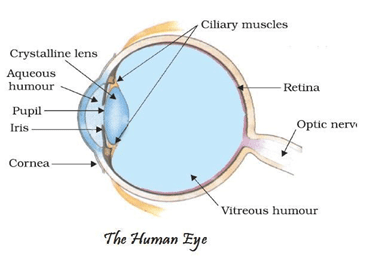
Question 11: Gurmit wanted to perform Activity 16.8 using a laser torch. Her teacher advised her not to do so. Can you explain the basis of the teacher’s advice?
Answer: Intensity of laser beam is very high, as it carries large amount of energy. It is harmful for eyes and can cause permanent damage. One should not look at laser beam directly or indirectly for a longer period.
Question 12: Explain how you can take care of your eyes.
Answer: To protect our eyes, the given points should be taken into account:
(i) Visit an eye specialist regularly.
(ii) Avoid reading in dim light and very bright light.
(iii) Avoid direct exposure of sunlight to the eye.
(iv) Clean your eyes with cold water quickly if dust particles or small insects enter your eye. Do not rub your eyes.
(v) Maintain a distance of at least 25 cm between the book and your eyes while reading.
Question 13: What is the angle of incidence of a ray if the reflected ray is at an angle of 90° to the incident ray?
Answer: We know that angle of incident ray is equal to angle of reflected ray.
⇒ ∠𝑖 = ∠𝑟
But it is given that
∠𝑖 + ∠𝑟 = 90°
⇒ ∠𝑖 + ∠𝑖 = 90° [Since, ∠i = ∠r]
⇒ 2∠𝑖 = 90°
⇒ ∠𝑖 = 45°
Angle of incidence = 45°.
Question 14: How many images of a candle will be formed if it is placed between two parallel plane mirrors separated by 40 cm?
Answer: Infinite number of images will be formed because of multiple reflections between the mirrors.
Question 15: Two mirrors meet at right angles. A ray of light is incident on one at an angle of 30° as shown in Fig. 16.19. Draw the reflected ray from the second mirror.
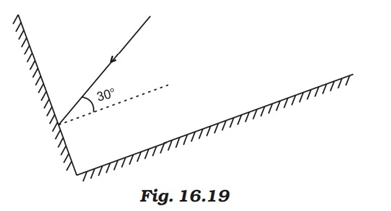
Answer:
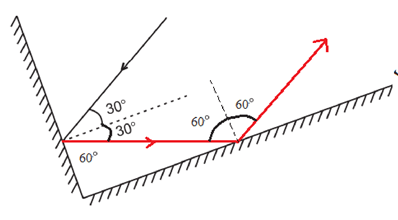
Question 16: Boojho stands at A just on the side of a plane mirror as shown in Fig. 16.20. Can he see himself in the mirror? Also can he see the image of objects situated at P, Q and R?
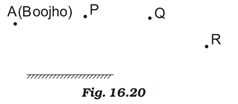
Answer: Boojho can’t see his own image because he is not standing in front of the mirror. However, he is able to see objects at P and Q because the rays coming from P and Q get reflected by the mirror and reach to his eyes. The ray from object R does not reflect and reaches Boojho, so, he cannot see object R.
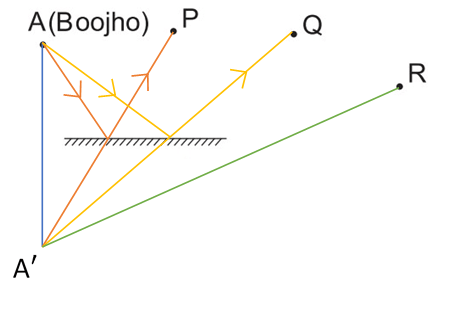
Question 17: (a) Find out the position of the image of an object situated at A in the plane mirror (Fig. 16.21).
(b) Can Paheli at B see this image?
(c) Can Boojho at C see this image?
(d) When Paheli moves from B to C, where does the image of A move?
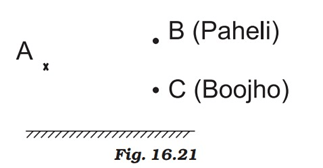
Answer: (a) The image of the object at position A will be formed behind the mirror. It will be at the same distance away from mirror as the object is.
(b) Yes. Paheli at B can see the object because reflected ray from A will reach B.
(c) Boojho can also see the image because his eyes receive the reflected ray from A.
(d) If we trace the reflected rays from B and C backwards, they converge at point behind the mirror. Position of image A remains fixed even if Paheli moves from B to C.
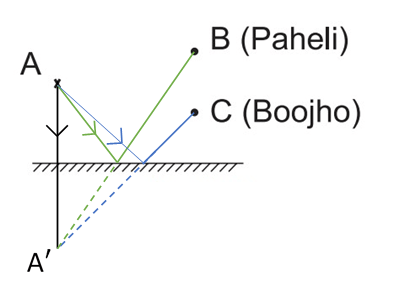
NCERT Solutions for Class 8 Science Chapter 16 – A Brief Discussion
CBSE Class 8 Science NCERT Solutions Chapter 16 helps students to clear their doubts and to score good marks in the board exam. All the questions are solved by experts with a detailed explanation that will help students complete their assignments & homework. Having a good grasp over CBSE NCERT Solutions for Class 8 Science will further help the students in their preparation for board exams and other competitive exams such as NTSE, Olympiad, etc.